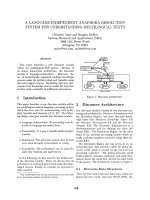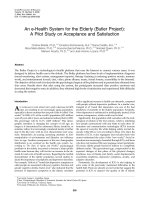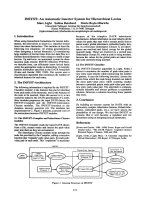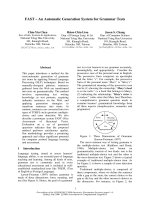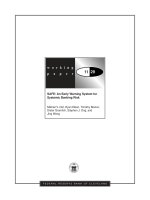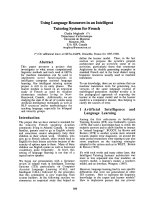An intelligent tutoring system for thai writing using constraint based modeling
Bạn đang xem bản rút gọn của tài liệu. Xem và tải ngay bản đầy đủ của tài liệu tại đây (1.31 MB, 107 trang )
AN INTELLIGENT TUTORING SYSTEM FOR THAI
WRITING USING CONSTRAINT BASED MODELING
TAN CHUAN WEI, JONATHAN
(B.Eng.(Hons), NUS)
A THESIS SUBMITTED
FOR THE DEGREE OF MASTER OF SCIENCE
SCHOOL OF COMPUTING
NATIONAL UNIVERSITY OF SINGAPORE
2005
... ACKNOWLEDGEMENTS ...
All these people have been a brilliant source of inspiration to me during the
challenging course of research.
•
My dear supervisors: Dr Liou Koujuch (I2R), A/P Chionh Eng Wee (SoC), and
Dr Titima Suthiwan (FASS) for their absolutely invaluable guidance and
support.
•
A/P Chee Yam San for his help and suggestions in the early stages of the
project.
•
My lab mates in LELS lab. Liu Yi, Yuan Xiang, Leilei, Zhen Jun, Chaochun,
and Yu Kuo who made working in the lab an awesome experience.
•
My “research assistant” Suanfong for bullet‐proof reading this thesis.
•
My friends. For being friends and making life bearable.
•
Family…for where would I be without them.
•
God for blessing me with each of the above, hearing every prayer, and thus
making this thesis possible. I should bold this.
ii
TABLE OF CONTENTS
SUMMARY .................................................................................................................. V
LIST OF TABLES.................................................................................................... VII
LIST OF FIGURES.................................................................................................. VII
CHAPTER 1 INTRODUCTION................................................................................. 1
1.1
1.2
1.3
Intelligent Tutoring Systems and Student Modeling...................................... 1
Research Objectives ....................................................................................... 3
Thesis Structure .............................................................................................. 4
CHAPTER 2 RESEARCH BACKGROUND ............................................................ 5
2.1
2.2
2.3
2.4
2.5
2.6
2.7
2.8
Student Modeling ........................................................................................... 5
Overlay Model ................................................................................................ 5
Bug Libraries .................................................................................................. 6
Machine Learning........................................................................................... 6
Model Tracing ................................................................................................ 8
Constraint Based Modeling .......................................................................... 10
Evaluation of CBM....................................................................................... 13
Work Related to CBM .................................................................................. 16
CHAPTER 3 THE DOMAIN OF THAI WRITING............................................... 18
CHAPTER 4 DESIGN FRAMEWORK................................................................... 22
4.1
4.2
4.3
Student Model (SM) ..................................................................................... 23
Pedagogical Model (PM).............................................................................. 24
Communication Model (CM) ....................................................................... 24
CHAPTER 5 STUDENT MODEL............................................................................ 27
5.1
5.2
5.3
5.4
5.5
Stereotyping.................................................................................................. 27
Constraint Hierarchy..................................................................................... 28
Dynamic Hierarchical Weighted Constraints (DHWC) ............................... 31
De-contextualized Constraint-Based Questions (DCBQ) ............................ 35
Uses of Student Model ................................................................................. 38
CHAPTER 6 IMPLEMENTATION ........................................................................ 41
6.1
6.2
6.3
Knowledge Engineering ............................................................................... 41
Constraints .................................................................................................... 45
Design of Exercises and DCBQ ................................................................... 47
CHAPTER 7 EVALUATION.................................................................................... 49
7.1
7.2
7.3
7.4
7.5
Methodology................................................................................................. 49
Procedure ...................................................................................................... 53
Results .......................................................................................................... 56
Discussion..................................................................................................... 66
Summary....................................................................................................... 67
iii
CHAPTER 8 CONCLUSION.................................................................................... 69
8.1
8.2
Overview and Contributions......................................................................... 69
Future work................................................................................................... 70
BIBLIOGRAPHY....................................................................................................... 74
APPENDICES............................................................................................................. 77
Appendix I: Constraints............................................................................................ 77
Appendix II: Detailed Ontology ............................................................................... 78
Appendix III: IPA characters.................................................................................... 80
Appendix IV: Thai alphabet ..................................................................................... 81
Appendix V: Pre-test and Post-test........................................................................... 82
Appendix VI : Feedback Form ................................................................................. 84
Appendix VII : Raw Student Model Variation Data ................................................ 86
Appendix VIII : Charts of Student Model Variation................................................ 96
iv
SUMMARY
Student Modeling offers great potential for Intelligent Tutoring Systems (ITS) as it
allows the system to understand the peculiarities of each individual student, much
like a personal tutor would. Student Modeling is a sub‐branch of User Modeling and
here we focus on the domain of Thai language teaching and develop a system to
iteratively refine and test our student model and enhancements.
We introduce Thairator, an ITS developed in JESS, which teaches Thai language
transcription using our new findings. The student is modeled using Constraint Based
Modeling (CBM), with several novel enhancements. While the research focus is
student modeling, this challenging domain is chosen for implementation to display
the real world use of the proposed techniques. First the domain is modeled in the
form of an ontology with the help of a domain expert. Then, the constraints are
extracted and coded into the domain knowledge of the system.
One of the weaknesses of the CBM technique is the inability to describe what the
student actually knows. Using our enhancements, we show the ability of the system
both to differentiate accidental conformance to constraints and more accurately
model the student’s strengths and weaknesses.
The CBM technique is enhanced with De‐contextualized Constraint Based
Questioning (DCBQ) and Dynamic Hierarchical Weighted Constraints (DHWC). The
former is used to identify student guesswork by extracting the relevant concepts of
the question that the student gets correct and posing a question that tests his higher‐
level understanding of these concepts. The latter is a structured hierarchy of weighted
v
constraints which represent important concepts in the domain. These are adjusted
throughout the use of the system to reflect the student’s competency in the various
concepts.
An empirical study is performed to evaluate the system. The subjects were put
through a pretest and posttest and the system log files studied to analyze the
reliability of the Student Model and benefits that the subjects gained from the system.
Further work will address issues regarding granularity of the student model and
how to further enhance it, further uses of the model, and how it can be applied to
other areas of use besides e‐learning and language teaching. In addition, machine
learning techniques will be explored to see how the construction of the ontology can
be made more automated.
vi
LIST OF TABLES
Table 1: Levels of feedback.......................................................................................... 40
Table 2: Detailed constraint violation in pre-tests and post-tests................................. 58
Table 3: User feedback on general impression of Thairator......................................... 64
Table 4: User feedback on pedagogical flow ............................................................... 65
Table 5: User feedback on DCBQs .............................................................................. 65
LIST OF FIGURES
Figure 1: 4-Component modular view of an ITS ........................................................... 1
Figure 2: System Architecture Diagram ....................................................................... 22
Figure 3: Basic Interface Layout .................................................................................. 25
Figure 4: Stereotyping dialog ....................................................................................... 28
Figure 5: Constraint Hierarchy ..................................................................................... 29
Figure 6: Feedback when student answer is wrong ...................................................... 35
Figure 7: Flowchart for DCBQ..................................................................................... 36
Figure 8: High-level transcription ontology ................................................................. 42
Figure 9: Part of detailed ontology: Clusters................................................................ 44
Figure 10: General structure of a rule [13] ................................................................... 45
Figure 11: Code for tone constraint for high consonants and long vowels .................. 46
Figure 12: Snapshot of the Thairator log...................................................................... 52
Figure 13: Flow of user study....................................................................................... 54
Figure 14: Learning Gains for each user ...................................................................... 56
Figure 15: Constraint violation in pretests and posttests.............................................. 57
Figure 16: Portion of chart comparing AT's SM at start and end of using Thairator... 60
Figure 17: Portion of chart comparing GB's SM at start and end of using Thairator... 62
Figure 18: Portion of chart comparing QB's SM at start and end of using Thairator... 63
Figure 19: Concept Schematic Graph........................................................................... 71
vii
CHAPTER 1 INTRODUCTION
1.1 Intelligent Tutoring Systems and Student Modeling
Intelligent tutoring systems are judged by three factors: their knowledge of the
domain to solve problems and draw inferences, their ability to deduce the student’s
ability in the domain, and the ability to implement pedagogical strategies to improve
student performance [1].
The first factor requires a method of representing the knowledge in a domain
(Expert Model), the second requires a student model while the third is closely tied to
the Pedagogical Model.
Here we use a modular view similar to Woolf’s [2] four component framework
shown in Figure 1. Other research [3] seperates the expert model from the domain
knowledge but we have seen no compelling reason to do so as these two components
can be better represented as one module. The communication model takes care of the
user interface and Human‐Computer modality issues.
Domain Knowledge
(Expert Model)
Student Model
Pedagogical Model
Communication Model
Student
Figure 1: 4-Component modular view of an ITS
1
Both the Domain Knowledge and Student Model are represented by CBM. The
Domain Knowledge is modeled as constraints which denote the boundaries of correct
behavior within the domain, while the Student Model in its most basic form is a
collection of violated constraints. Later, we go into more detail regarding these two
modules and describe our enhancements to the Student Model that allow a better
representation of the student’s ability.
One of the main weakness of CBM is that it does not accurately reflect what the
student knows. Ohlsson [4] states that the relevant and satisfied constraints are only
candidates for understood concepts in the student’s knowledge as they could have
been satisfied accidentally.
Here we enhance the CBM by using Dynamic Hierarchical Weighted Constraints
(DHWC): a heuristic method of weighting constraints and De‐contextualized
Constraint‐Based Questions (DCBQ). The former allows the constraints to accurately
reflect the strengths and weaknesses of the student, while the latter helps us
differentiate between students who satisfy the constraints accidentally from those
who have a methodology behind their actions. Such an enhancement is significant as
the pedagogical actions for these two groups of people are very different.
Due to the interdependent nature of the modules in an ITS, it is difficult to research
the individual components in isolation. As such, Thairator, a complete ITS has been
implemented. Our chosen domain is Thai language transcription. In linguistics,
transcription is the process of matching the sounds of human speech as represented
by International Phonetic Alphabet (IPA) [5] (eg. khâaw; see Appendix III: IPA
characters) to written symbols such as Thai script (eg. ขาว; see Appendix IV: Thai
2
alphabet). This complex domain has numerous rules and exceptions (discussed in
CHAPTER 3) and to the best of our knowledge, no ITS with a decent student
modeling module has been produced to teach Thai or any script‐based language.
1.2 Research Objectives
Our research aims to develop an enhanced Constraint‐Based Student Model for the
teaching of Thai writing transcription. The work is based on Ohlsson’s [4] original
description of CBM as a viable alternative technique for student modeling.
Enhancements are made to the original technique to improve its performance and
address some of the main weaknesses such as its inability to understand what the
student knows and the need to store correct answers.
We aim to study the uses of CBM and implement it in the domain of computer‐
aided language learning. For the specific domain of Thai writing transcription, we
seek to develop an ontology to represent the hierarchy and relationships between
individual concepts. This is tedious work but is invaluable in helping to gain an
overview of the domain and model necessary constraints from it. Within the domain
of teaching the transcription of languages, the higher levels of this ontology (see
section 6.1) would be reusable.
We adopt an iterative approach in the design and implementation of our ITS, called
Thairator, which is a system that guides students in the transcription of Thai script
into phonetics. Personalized exercise selection and feedback are provided based on
the Student Model maintained. A user study is then carried out to analyze the
tangible benefits of this novel system.
3
1.3 Thesis Structure
This thesis is organized into eight chapters in the following way:
Chapter 2, Research Background, introduces the background research on student
modeling, in particular reviews the existing work on CBM. This chapter also studies
the strengths and weaknesses of this technique and other related work.
Chapter 3, Thai Writing Domain, discusses the suitability and limitations of the Thai
transcription domain for implementation.
Chapter 4, Design Framework, presents the design of the four components of our
ITS. They are the Student Model (SM), Pedagogical Model (PM), Domain Knowledge
(DK), and Communication Model (CM).
Chapter 5, Student Model, talks about the design of the Student Model used in
Thairator. It also details our enhancements and contributions and discusses how the
Student Model is utilized to customize treatment for each student.
Chapter 6, Implementation, begins with a description of the various software tools
used in creating the ITS. The methology used to extract the constraints and
implement them in JESS are covered in detail. The considerations in designing the
exercise content and feedback are also covered in this chapter.
Chapter 7, Evaluation, describes the evaluation methodology and presents results of
the user study performed with Thairator.
Chapter 8, Conclusion, summarizes the contributions and achievements of our thesis
and suggests some possible future work to extend our research.
4
CHAPTER 2 RESEARCH BACKGROUND
2.1 Student Modeling
A Student Model is a qualitative representation that accounts for student behavior in
terms of existing background knowledge about a domain and about students learning
the domain. [6]
The point of student modeling is to be able to tailor instruction for each student and
provide information for the pedagogical model. Many techniques have been
developed thus far in the field of Student Modeling. These include the overlay model,
bug libraries, machine learning, model tracing, and constraint based modeling. We
focus especially on the last technique as it is the foundation for our research.
2.2 Overlay Model
The overlay model [7] is the most common student model in use. In essence, it
models the studentʹs knowledge as a subset of that of an expert. This is more
applicable when the domain content is representable as a prerequisite hierarchy. The
overlay model then indicates how far the student has progressed in acquiring the
domain knowledge with respect to that of the expert.
This technique is usually effective at representing what the student knows.
However, if the representation view of the expert is different from that of the student
then the overlay model may not be useful. Hence, it is very difficult to infer student
misconceptions from an overlay model. The problem of addressing misconceptions is
addressed by the following Student Modeling techniques.
5
2.3
Bug Libraries
Also known as the buggy model, this technique attempts to represent the false
knowledge of the student in terms of a set of bugs or misconceptions. To achieve this,
the students’ errors must be studied and a library of bugs built. By mapping the
student’s actions to bugs in the library, it is possible to determine the errors in the
studentʹs understanding. An inference engine is used to match error explanations to
student errors. If the bug is not found in the library, the student error is matched with
some combination of existing bugs. This may lead to misdiagnosis of the student’s
misconceptions.
A modified version of this technique is to construct bugs from a library of bug parts.
This is used in the ACM system [8] where each diagnosed bug is created from a
library of smaller bug parts. A small number of bug parts can combine in various
ways to represent a large number of student errors.
Bug libraries are often used to augment the overlay model so that diagnosis of
faulty knowledge is addressed. However, two things need to be noted: (1) it is often
tedious and sometimes not possible to model a complete bug library, and (2) research
has revealed that the effort in constructing bug libraries may not be transferable
between different student populations [9].
2.4 Machine Learning
Machine learning is the induction of new knowledge or rearrangement of existing
knowledge in an attempt to improve performance of a task. The machine learning
method of Student Modeling saves on the empirical analysis required by bug libraries
but is computationally very expensive as it searches the problem space for a path to
6
an incorrect student answer. Most machine learning methods used can be broadly
divided into supervised inductive learning, unsupervised inductive learning and
reinforcement learning. These are discussed below. The implementations of these
methods commonly include Bayesian networks, Neural networks, Decision trees, and
Support Vector Machines [6]. The machine learning algorithms and techniques we
have identified are only a small sampling of the vast number available but they are
representative of the field and sufficient for the purposes of our research.
2.4.1 Supervised Inductive Learning
Also known as empirical learning or learning from examples, supervised inductive
learning is reliant on existing data (or objects) to produce general hypotheses. These
hypotheses have varying degrees of certainty. In supervised learning, the objects
generalized from are labeled – that is, they are identified manually by a human
supervisor and fed into the system. In the domain of student modeling, supervised
inductive learning systems are used to induce student models from existing
behaviors. However, the quality of the induced student model varies considerably
with the degree of noise from the input behaviors [6].
2.4.2 Unsupervised Inductive Learning
In unsupervised learning, the objects used for learning are unlabelled, making it a
harder problem than supervised learning. The main approach to generalizing
unlabeled instances is conceptual clustering [10], which involves a search for
‘regularities’ in the objects presented. Although it is a technique commonly used on
7
ill‐structured domains, in general, unsupervised inductive learning is characterized
by difficulties in formulating goals and success criteria [6].
2.4.3 Reinforcement Learning
This technique consists of two components: the environment and the actions. The
environment is beyond the direct control of the software agent while the actions are
selectable by him. The agent examines the current state and selects an action to
perform. The environment then observes the effects of this action and based on the
new resulting state, the agent is given a reward based on previous estimates of this
state’s value. Basically, reinforcement learning (RL) rewards the agent for good
performance and the agent’s goal is to maximize the long‐term rewards. This
technique has been shown to be flexible in handling noisy data, and does not need
expert domain knowledge. However, it produces more variance during learning due to
the next state being used as the target value rather than the final state. The result of
this is that RL takes a longer time to converge to optimum values as compared to other
student modeling techniques [11].
2.5 Model Tracing
Model Tracing (MT) [12], developed by John Anderson at Carnegie Mellon
University, is another technique of Student Modeling. It models the cognitive
processes of the student and is used successfully in several tutoring systems such as
the mathematics tutor produced by Carnegie Learning Inc.
MT is also a popular technique in cognitive tutors like the LISP tutor which is also
based on the ACT‐R theory of cognition [12]. In essence, the student is monitored
8
while problem‐solving and each step made is modeled by identifying a production
rule in the domain knowledge that could have generated it.
The model tracing algorithm requires three inputs [13]:
1. The state of working memory: represented by a group of working memory
elements (WMEs)
2. A set of production rules; each representing a cognitive step performed by the
student.
3. The student input.
MT uses these inputs to attempt to find a sequence of production rules that generates
the given student input. If such a sequence is found, the resulting trace of production
rules is used to generate feedback messages.
In MT, there are two long‐term memory stores: declarative and procedural. The
student acquires declarative knowledge first and this is later turned into procedural
knowledge which is goal‐oriented and hence more efficient to use. The procedural
knowledge is represented as production rules around which instruction is organized.
It is useful to compare MT with CBM as these are two popular yet fundamentally
different Student Modeling techniques. This would shed some light on the tradeoffs
between the rigouous and detailed MT as compared to the more flexible yet less
detailed CBM.
A major disadvantage of the MT technique is that it requires much empirical study to
model the domain completely as production rules. As much as 200 hours of
development time is required to produce one hour of instruction [13]. In addition,
such systems are shown to be domain specific, as without modification, they do not
9
work very well once the user group is changed. This is because students with
different backgrounds may not use the same rules to solve the same problem. It is
also difficult to implement for more complex and open‐ended domains such as
teaching English grammar and design domains. As such, it is more suited for well‐
defined domains such as arithmetic and geometry.
Cognitive modeling systems, such as MT, also fare poorly at handling exploratory
behavior, and wildly incorrect behavior. Furthermore, it is intolerant of missing rules in
the domain knowledge as any such omission will render the system unable to check if
the student is correct for any path that uses that missing rule.
Cognitive tutors generally also provide immediate feedback from each step the
student takes and this limits the possibility of the student generating a complete
wrong answer [14].
The Cognitive Tutor Authoring Tools (CTAT) project [15] at Carnegie Mellon is a
set of tools designed to help in the development of ITS using the Model Tracing
technique. The tools include a GUI builder, a behaviour recorder, a production rule
editor, and a cognitive model visualizer.
2.6 Constraint Based Modeling
First suggested by Ohlsson [4] in the mid 1990ʹs as a technique to represent the
domain knowledge and student model for an ITS, this innovative student modeling
technique has the advantages of adaptability, recognition of unanticipated but correct
answers, and facilitation of exploratory behavior in students.
Ohlsson suggests that diagnostic information does not reside in the sequence of
actions made by the student but in the situation created after each action. In other
10
words, there exists no correct solution path which traverses a bad problem state. An
analogy from the real world example of driving would be teaching someone to
respect the direction along a one‐way road. The direction of the one‐way road is the
constraint. It does not matter how the driver ended up in the wrong direction, once
he is in the wrong direction on a one‐way road, he has violated the constraint and
corrective measures need to be taken.
The recent use of this powerful technique has been mainly in teaching technical
content such as SQL [16], data structures in C [17], arithmetic [18], database
normalization (NORMIT) [19], database design (KERMIT) [20], and simple English
punctuation (CAPIT) [21].
CBM focuses on faulty knowledge and the resulting problem states rather than the
studentʹs actions. The student is modeled in terms of equivalence classes of solutions
rather than specific solutions or strategies. The members of a particular equivalence
class are the learner states that require the same instructional response. The logic is
that no correct solution can be arrived at by traversing a problem state that violates a
fundamental principle of the domain.
Because the space of false knowledge is much larger than the space of correct
knowledge, Ohlsson suggests the use of an abstraction mechanism realized in the
form of state constraints. A state constraint is an ordered pair (Cr, Cs), where Cr is the
relevance condition and Cs is the satisfaction condition. Cr is used to identify the
equivalence class, or the class of problem states in which Cr is relevant. Cs identifies
the class of relevant states in which Cs is satisfied. Each constraint specifies the
property of the domain that is shared by all correct paths. In other words, if Cr is
11
satisfied in a problem state, in order for that problem state to be a correct one, it must
also satisfy Cs. Constraints define sets of equivalent problem states. A violated
constraint signals an error, which translates to incomplete and incorrect student
knowledge.
All problem solving steps are not equally significant for diagnostic purposes. Some
steps spring directly from the student’s conceptual understanding of the problem and
hence contain more diagnostic information than others. This implies that we can
achieve abstraction by selectively focusing on certain important steps.
To illustrate, let us look at a simple example of fractional addition taken from [4].
Consider a child adding two simple fractions.
1/4 + 2/3 =
Suppose the student proceeds to draw a fraction bar on the right hand side of the
equation.
1/4 + 2/3 = /
While this is a problem solving step, its significance is minimal and has little
diagnostic value. However, suppose the student’s next step is to fill in the numerator
on the right hand side.
1/4 + 2/3 = 3/
Now we immediately can guess what the student is doing. He is adding the two
numerators together and there is a high possibility that he will also add the
12
denominators together also. Resulting in the erronous answer of 3/7. The relevance
constraint in this case will be:
(n1/d1 + n2/d2 = n/d) and
(n = n1 + n2)
That is, this constraint is only relevant when the student is adding fractions (eg. for
fractional multiplication it is irrelevant) and when the student adds the two
numerators together. The satisfaction constraint that must be true is
d1 = d2
meaning that the two denominators must be the same.
This example shows that the diagnostic information does not reside in the sequence
of actions executed by the student but rather in the problem state he creates.
2.7 Evaluation of CBM
We take a closer look at CBM as it is the focus of our research. In this section, we
evaluate the strengths and weaknesses of CBM and point out which specific
weaknesses we attempt to address.
2.7.1 Strengths of CBM
First, it is robust when dealing with creative students who come up with correct
solutions that the implementer did not think of. This is related to the fact that it is
independent of the studentʹs problem solving strategy, and hence able to monitor
unrestricted exploration. It also handles radical strategy variability [4] well. Radical
strategy variability is when a student switches problem solving strategy half‐way
13
through a question. In general, this is hard for student modeling systems to detect or
understand. CBM does not try to understand exactly what the student is trying to do
and so handles such situations very well. This flexibility makes it suited to model
open‐ended domains such as grammar teaching and database design where there are
many alternative solutions.
There is also no need for a separate expert model, bug library nor runnable domain
module. As such, time consuming empirical studies to tune parameters are also not
necessary. In general, modeling the constraint boundaries of a domain is a much
easier task than modeling all the possible production rules (e.g. as in model tracing).
Furthermore, the system is not crippled by incomplete domain constraint
knowledge. For example, the effect of a missing constraint is localised and not
catastrophic as the system is merely prevented from detecting a particular type of
error.
In addition, it is computationally inexpensive ‐ simple pattern matching is used to
determine which constraints are relevant and have been violated.
A further advantage is that it is neutral with respect to pedagogy, which is left to
the separate pedagogical component to implement. This is useful as the neutrality
allows the ITS implementer to utilize any combination of pedagogical methods that
he deems most suitable for his target students.
2.7.2 Weaknesses of CBM
Despite its many advantages, there are some disadvantages in CBM. Firstly, for
some domains it might be difficult or impossible to identify properties of problem
states which are informative with respect to the studentʹs understanding. This might
14
result in a set of constraints that provide too loose a net and allow incorrect solutions
to slip through. We address this by first building an ontology of the domain and
extracting the constraints from there.
Secondly, present implementations of CBM generally require ideal answers to be
stored in the system. These tagged ideal solutions are then compared with the
studentʹs answers. In our implementation, ideal solutions do not need to be stored as
the constraints and their bindings are sufficient to guide the student to the complete
solution. To achieve this, our constraints are mainly encoded purely as pattern
matches [22]. However, a difference is that our constraints need not model the
domain completely. In our case, only for the exceptional cases where the answer is
ambiguous due to gaps in the domain knowledge do ideal answers need to be stored.
This is elaborated further in CHAPTER 3 where an example of such ambiguious
situations is discussed.
Thirdly, the student behavior may be accidental. CBM focuses on problem states
rather than on action sequences. As such, goal hierarchies, plans, weak methods etc.
are ignored and what the student knows is not described. Furthermore, there is no
differentiation between factual errors, errors in the underlying goals, and errors in
translating the goals into actions.
In our research, we attempt to address these three weaknesses. De‐contextualized
Constraint‐Based Questions (DCBQ) described in chapter 4 are used to identify
student guesswork and accidental behavior. In addition, we also have developed a
system of Dynamic Hierarchical Weighted Constraints (DHWC) that provides a novel
15
and structured heuristic method for analysing the student’s strengths and
weaknesses.
2.8
Work Related to CBM
Regarding research pertaining directly to CBM, although there has not been much
change in the core idea since it was introduced, several implementations, extensions
and successful evaluations have been done. We discuss the main work below.
Martin and Mitrovic show that given a complete domain model, and using an
alternative representation of CBM, it is possible to rebuild the solution from the
relevant constraints and their bindings [22]. Their novel system generates corrected
versions of student answers for use as feedback. However, requiring a complete
domain model requires tedious work to ensure that all possible constraints are
included. This negates the benefit that CBM need not be fully complete and correct to
function. Furthermore, there is no guarantee that the generated solution will converge
even though experiments using SQL‐tutor have been reasonably successful.
Martin and Mitrovic also suggest a method of automatic problem set generation
[23] that produces problems that better represent combinations of constraints with
minimal human effort. Implementing such problem generation in real‐time would
also necessitate a natural language processing engine. Once again, the constraint set
needs to be complete or the generated questions may contain errors.
Zhou and Evens describe their CIRCSIM conversational tutor for teaching medical
students. It uses multiple student models concurrently to support tutoring decisions
[24]. Their student model includes: a performance model, a student reply history, a
16
student solution record (using CBM), and a tutoring history using a hierarchical
planning mechanism.
Martin and Mitrovic have also developed WETA: a web‐based authoring
environment to aid rapid development of CBM systems [25]. This, unfortunately, is
not available for public testing unlike CTAT described earlier in section 2.5.
Mayo and Mitrovic experiment using a probabilistic approach to determine a
problem of appropriate difficulty to next present to the student [26]. This deals with
both the Student Model and Pedagogical Model. They state that constraints are
usually not independent and require heuristics both for problem selection and to
determine the amount of feedback to give.
Suraweera discusses the automatic extraction of contraints from a domain ontology
[27] which facilitates more rapid development of ITS. This yet to be completed
research also looks into machine learning to acquire both procedural and declarative
knowledge.
None of the above research addresses the issue of differentiating between students
who satisfy constraints accidentally and those who know what they are doing. This
deficiency is addressed in the following chapter using a novel combination of
heuristics and a weighted constraint system that promises a more accurate
representation of the student.
17
CHAPTER 3 THE DOMAIN OF THAI WRITING
ʺHow best to teach a language?ʺ is a classic question in applied linguistics. In this
case we have chosen the domain of Thai transcription from the broad scope of
Intelligent Computer‐aided Language Learning (ICALL) to show the usefulness and
applicability of our student model.
This domain has been specially selected for its difficulty, ambiguity, and presence of
a real world problem: that of the shortage of experienced teachers to help students
make the transition from phonetics to Thai script. The difficulty and ambiguity can be
seen in the complexity of the various transcription rules that need to be applied in
different contexts. This is explained further below.
This is not a trivial domain since the mapping from phonetic alphabets to Thai
script does not consist merely of simple 1‐to‐1 relationships. There are numerous
overlapping rules and exceptions, and the mapping changes depending on the
context (position of character and its surrounding characters) of the consonant or
vowel. In some situations, the rules are ambiguous and the pronounciation to choose
can only be learnt by practice. It is also in this unique area that we use the power of
CBM to tolerate multiple correct answers; albeit in a different way.
Let us take a closer look at the ambiguity in this domain. The Thai phonetics nâa
can be mapped to two possible Thai scripts. หนา which means face or page or season,
and นา which is a verb prefix. Likewise, transcribing in the other direction, the script
โหม can be mapped to either hǒom or mǒo using our domain knowledge.
18

